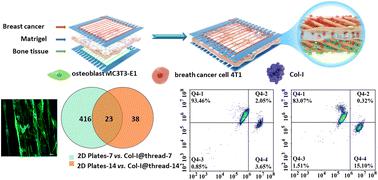Our official English website, www.x-mol.net, welcomes your
feedback! (Note: you will need to create a separate account there.)
Probing the interaction between metastatic breast cancer cells and osteoblasts in a thread-based breast–bone co-culture device
Lab on a Chip ( IF 6.1 ) Pub Date : 2023-05-31 , DOI: 10.1039/d3lc00106g Shi Ming Wu 1 , Feng Chen 1 , Xiao Yan Yang 1 , Teng Fei Wu 2 , Wei Sun 3 , Ling Yu 1
Lab on a Chip ( IF 6.1 ) Pub Date : 2023-05-31 , DOI: 10.1039/d3lc00106g Shi Ming Wu 1 , Feng Chen 1 , Xiao Yan Yang 1 , Teng Fei Wu 2 , Wei Sun 3 , Ling Yu 1
Affiliation

|
Breast cancer metastasis to bone is a leading killer in breast cancer patients. A type I collagen-modified thread (Col-I@thread) was prepared for 3-dimensional cell culture and breast cancer bone metastasis co-culture device assembly. First, the coating of Col-I on nylon threads for promoting cell adhesion and growth was studied. Through SEM, XPS, and protein concentration measurements, it was found that the lyophilization method remarkably preserved the Col-I activity and the internal structure of the thread, thereby promoting cell attachment and proliferation. RNA-sequencing (RNA-Seq) and quantitative PCR analysis showed that osteoblast cells (MC3T3-E1) grown on Col-I@thread had elevated RUNX2, ALP, OPN, and Col-I gene expression to promote osteoblast differentiation. Single-cell analysis found that osteoblast MC3T3-E1 cells growing on Col-I@thread had higher Ca2+ secretion activity and mineralized nodules, suggesting robust cell activity and bone matrix formation than cells growing on 2D culture plates. Col-I@threads were knotted in an interdigital cross-finger frame to assemble the breast cancer–bone co-culture model. Confocal microscopy and flow cytometry tests quantified the invasive breast cancer cells. Moreover, the thread-based co-culture devices allowed us to isolate the invasive and non-invasive breast cancer cells to compare their molecular characteristics. qPCR results showed that expression of CX43, CXCR5, and CSPG4 genes was significantly increased in breast cancer cells with bone metastasis. Meanwhile, the expression of RUNX2 and OPG genes in osteoblasts was inhibited. The co-culture model based on the Col-I@thread mimics the bone tissue microenvironment to reveal the cross-talk between cancer cells and bone tissue. Moreover, the thread-based co-culture device is easy to fabricate and operate, providing a platform for exploring the cellular and molecular mechanisms of breast cancer bone metastasis, and holds potential for high-throughput screening of anti-breast cancer bone metastasis drugs.
中文翻译:

在基于线的胸骨共培养装置中探索转移性乳腺癌细胞与成骨细胞之间的相互作用
乳腺癌骨转移是乳腺癌患者的头号杀手。为三维细胞培养和乳腺癌骨转移共培养装置组装准备了 I 型胶原修饰线 (Col-I@thread)。首先,研究了 Col-I 在尼龙线上的涂层以促进细胞粘附和生长。通过SEM、XPS和蛋白浓度测量发现,冻干法显着保留了Col-I活性和丝状物的内部结构,从而促进细胞贴壁和增殖。RNA 测序 (RNA-Seq) 和定量 PCR 分析表明,在 Col-I@thread 上生长的成骨细胞 (MC3T3-E1) 具有升高的 RUNX2、ALP、OPN 和 Col-I 基因表达,从而促进成骨细胞分化。2+分泌活动和矿化结节,表明细胞活性和骨基质形成比在 2D 培养板上生长的细胞强。Col-I@threads 被打结在一个叉指框架中,以组装乳腺癌-骨共培养模型。共聚焦显微镜和流式细胞术测试对浸润性乳腺癌细胞进行了量化。此外,基于线的共培养装置使我们能够分离侵入性和非侵入性乳腺癌细胞以比较它们的分子特征。qPCR 结果显示,CX43、CXCR5 和 CSPG4 基因的表达在具有骨转移的乳腺癌细胞中显着增加。同时,成骨细胞中RUNX2和OPG基因的表达受到抑制。基于 Col-I@thread 的共培养模型模拟骨组织微环境,以揭示癌细胞与骨组织之间的相互作用。此外,基于丝线的共培养装置易于制造和操作,为探索乳腺癌骨转移的细胞和分子机制提供了平台,具有高通量筛选抗乳腺癌骨转移药物的潜力。
更新日期:2023-05-31
中文翻译:

在基于线的胸骨共培养装置中探索转移性乳腺癌细胞与成骨细胞之间的相互作用
乳腺癌骨转移是乳腺癌患者的头号杀手。为三维细胞培养和乳腺癌骨转移共培养装置组装准备了 I 型胶原修饰线 (Col-I@thread)。首先,研究了 Col-I 在尼龙线上的涂层以促进细胞粘附和生长。通过SEM、XPS和蛋白浓度测量发现,冻干法显着保留了Col-I活性和丝状物的内部结构,从而促进细胞贴壁和增殖。RNA 测序 (RNA-Seq) 和定量 PCR 分析表明,在 Col-I@thread 上生长的成骨细胞 (MC3T3-E1) 具有升高的 RUNX2、ALP、OPN 和 Col-I 基因表达,从而促进成骨细胞分化。2+分泌活动和矿化结节,表明细胞活性和骨基质形成比在 2D 培养板上生长的细胞强。Col-I@threads 被打结在一个叉指框架中,以组装乳腺癌-骨共培养模型。共聚焦显微镜和流式细胞术测试对浸润性乳腺癌细胞进行了量化。此外,基于线的共培养装置使我们能够分离侵入性和非侵入性乳腺癌细胞以比较它们的分子特征。qPCR 结果显示,CX43、CXCR5 和 CSPG4 基因的表达在具有骨转移的乳腺癌细胞中显着增加。同时,成骨细胞中RUNX2和OPG基因的表达受到抑制。基于 Col-I@thread 的共培养模型模拟骨组织微环境,以揭示癌细胞与骨组织之间的相互作用。此外,基于丝线的共培养装置易于制造和操作,为探索乳腺癌骨转移的细胞和分子机制提供了平台,具有高通量筛选抗乳腺癌骨转移药物的潜力。











































 京公网安备 11010802027423号
京公网安备 11010802027423号